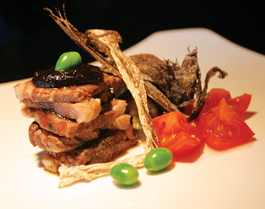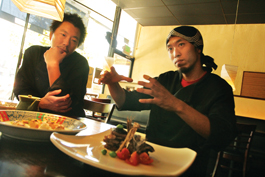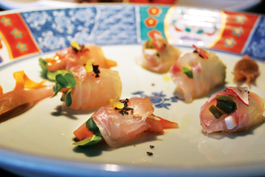home | metro silicon valley index | silicon valley restaurants | review

Photograph by Felipe Buitrago
STACKED: Layered beef is prepared with an infusion technique called kombu jime.
A Question of Taste
It's what makes babies love breast milk and the rest of us love Doritos. It's the secret weapon of Japanese chefs. It's behind the controversy over MSG. It's umami—the taste you didn't know you couldn't get enough of—and scientists are finally beginning to understand why it's important.
By Stett Holbrook
THE LIGHTS were dimmed and a hush fell over the room as an army of well-choreographed waiters delivered chef Kunio Tokuoka's appetizer to rapt diners in a posh downtown San Francisco hotel. Tokuoka, chef of the celebrated Kyoto restaurant Kitcho, had prepared five tiny but infinitely delicious dishes served on a plate illuminated by the flickering glow of a votive candle inside the translucent walls of a thinly shaved daikon radish.
Next up was San Francisco chef Hiro Sone's salad of ginger-poached Georgia shrimp and watermelon. The main course of slow-cooked lamb rib-eye was the work of none other than Thomas Keller, chef and owner of the Napa Valley's French Laundry restaurant and New York's Per Se, two of the top-rated restaurants in the world.
Each chef introduced his dish to the crowded ballroom, but the real stars of the show were three lesser-known characters: glutamate, inosinate and guanylate, amino acids and nucleotides that create a savory, delicious, mouth-filling taste known as umami (pronounced "ooh mommy") that was behind all the exquisite food being served.
The lunch was part of the Umami Symposium, an event presented by Japan's Umami Information Center earlier this summer. The conference was aimed at boosting awareness of umami and celebrating the 100th anniversary of its discovery.
Umami is a Japanese term that translates as "deliciousness." It's known as the fifth taste (after sweet, sour, salty and bitter) and it occurs in foods as diverse as seaweed, Parmesan cheese, mushrooms, asparagus, ketchup, shellfish, ripe tomatoes, green tea, cured meats and chicken soup. Glutamate, inosinate and guanylate each have a powerful effect on taste, but when they're combined the taste of food undergoes an exponential increase in deliciousness. It's culinary magic.
I attended the event because I wanted to sample the food prepared by such big-name chefs, but also because I wanted to learn more about umami. And I did learn a lot. The presence of glutamate and other compounds signal to the brain the presence of protein and they push a powerful pleasure button. While there have been doubts among scientists about whether umami was a real phenomenon, independent of other tastes, recent discoveries of taste receptors on the tongue have settled the debate. Umami is legit.
But as I sat at my table digging into my umami-dense lunch and digesting what I'd heard at the panel discussion of distinguished scientists, I couldn't help but wonder what the point of it all was. Why, I asked myself, does umami matter?

Photograph by Felipe Buitrago
CULINARY THEORISTS: Chefs Shoichi Shiono (right) and Seishiro Takaoka plan future tastes at Nami Nami in Mountain View.
The Return of MSG
For instance, why would the Umami Information Center spend so much money just to publicize umami? The nonprofit group, which gets support from corporations that produce glutamate such as Ajinomoto, has been holding symposia all over the world at great expense as part of the anniversary of umami's discovery by Japanese scientist Kikunae Ikeda. But what's in it for them? Did they just want people to eat more ripe tomatoes and salami? Or was it the educational goodwill tour the group insists it is?
Maybe the event was part of a plot to get the world to drop its fear of monosodium glutamate, the dreaded MSG. Soon after glutamate was discovered as one of the sources of umami, Ajinomoto developed MSG as a flavor enhancer. MSG was enjoying a great ride until people started complaining of headaches and hot flashes they associated with MSG in the food they ate, particularly in Chinese food. Chinese Restaurant Syndrome was born and MSG fell out of favor.
But it's since been proven that Chinese Restaurant Syndrome is bunk and MSG is not the evil it's made out to be. Was the Umami Symposium an effort to pave the way for MSG's comeback? Nah, too conspiratorial. MSG is already back; it just goes by different names now, like "hydrolyzed soy protein" and "autolyzed yeast," which are synthetic forms of glutamate.
I could see the appeal of the event to the scientists and food product developers in attendance, but the symposium was open to the public. Why should they care about umami?
I never figured out what the tight-lipped Umami Information Center's motivation was, but after talking to scientists and chefs I concluded umami is worth understanding if for no other reason than that it makes us better educated eaters. If we are what we eat, then knowledge about what we're eating and how it affects us is worth knowing. Chefs and flavor scientists are well aware of umami's power of the palate and are making great use of it. The rest of us should be in on the secret as well.

Photograph by Felipe Buitrago
Let the Good Tastes Roll: Umami-rich sashimi wrapped around squid liver and pickles seduces the eye and palate at Nami Nami.
Naming the Taste
Our love affair with umami starts at an early age. Human milk is packed with 10 times the glutamate of cow's milk and the pleasurable hit of umami we receive at our mother's breast stays with us. We want more. Ooh mommy, indeed.
"There is something in human-ness that really aims us toward this particular taste," says Dr. Gary Beauchamp, director and president of the Monell Chemical Senses Center in Philadelphia, the world's first scientific institute for research on taste, smell and chemosensory irritation.
Beauchamp, who was one of the panelists at the Umami Symposium, studies neural biology and what factors influence what we taste. He says taste is the most important sense we have because at a fundamental level it tells us whether the food we put in our mouths is safe to eat or not.
While umami is closely associated with Japan, it's not unique to the country. Beauchamp says U.S. food producers keyed into umami as far back as 75 years ago. Soup manufacturers called it "the essence of chicken soup" or "the essence of deliciousness."
The use of the word umami today is "just putting a name to it," he says.
One of the interesting things about umami is that everyone has tasted it, whether they're aware of it or not. People just know that dishes made with a rich chicken stock or Parmesan cheese baked with tomatoes taste really good.
"We intuitively notice when it's in food," says Beauchamp.
Dr. Sue Kinnamon, a professor of biological sciences at Colorado State University, studies taste transduction, how the tongue tells the brain about taste. To help her students tune in to umami, she conducts a simple experiment. She opens up a bag of Lay's potato chips and a bag of Doritos and asks students to try both. Both chips have about the same amount of salt, but one is loaded with umami and the students quickly conclude the Doritos is the one with the secret ingredient.
"It hits the button," she says. "I don't know about you, but I love Doritos."
Nacho-cheese-flavored Doritos contain five separate forms of glutamate and may be even richer in umami than the best kombu dashi (kelp stock), according to a recent story in The New York Times about the various guises of MSG in food. Dashi, a broth made from kombu seaweed, dried fish and shiitake mushrooms, is a fundamental ingredient in Japanese cuisine and a mother lode of umami since it combines glutamate, inosinate and guanylate.
The Umami Experiment
Umami has important medical uses for people who have lost their sense of taste because of radiation therapy, malnutrition or other medical conditions. But what about the rest of us?
"There's a hedonic component," says Kinnamon. "People just like good food."
I conducted a little experiment of my own. My subject? Ava, my 8-month-old daughter. Armed with the knowledge that breast milk is loaded with glutamate and that my daughter sometimes turns up her nose at the puréed yams I feed her, I added a little chicken stock, an umami-packed ingredient. The result was dramatic. I couldn't feed her fast enough. Later, I brewed up a batch of dashi and added it to a cruel-looking gruel of oatmeal. As the spoonful of dashi-enriched cereal hit her tongue, a look of pure bliss washed over her face and she opened her mouth for more like a baby bird in a nest. This umami stuff really works.
New research is probing how umami lights up the brain's pleasure centers. Dr. Edmund T. Rolls, a professor of experimental psychology at the University of Oxford, has studied how umami makes us feel good. His research has shown that there are areas of the brain that recognize umami as a distinct taste, specifically the orbitofrontal cortex, where taste and smell imputs are translated into the sensation of pleasure. That's why moans of pleasure that come from delicious food can sound a bit like moans of another kind. Umami's pleasure-producing effect on the brain is our body's way of telling us to eat more of the stuff. The brain is smart like that.
Rolls' research has also shown how hunger influences how good umami tastes. We seek out umami-rich foods when we're hungry, but once we're full they don't taste as good.
"This phenomenon is the most important factor that decides how much you eat at a meal," Rolls said at an umami panel discussion held in England last year. "This has a lot of implications if you are trying to lose weight and lots of implications if you are trying to boost someone's food intake. We call it sensory specific satiety."
Rolls demonstrated sensory specific satiety by monitoring activity in the orbitofrontal cortex of experiment subjects while they drank umami-rich tomato juice. As they filled up on tomato juice, Rolls said the pleasantness rating in the brain declined. The implication is that brain has a built in regulator that tries to prevent us from overeating.
Marketing Deliciousness
While umami is still an esoteric subject to the public at large, the food service and product development industries are already hip to it. A recent article in Functional Ingredients, a trade magazine for the health and nutrition industry, drew on Rolls' research and its application to food production.
"Product developers can also use knowledge of umami to influence consumer demand," the article says. "People may not be aware of it, but research has shown that they find products more pleasurable when flavour enhancement is used to improve palatability. ... With its flavour-enhancing properties, umami has the potential to make dishes that are nutritionally beneficial more desirable and as a result drive product selection toward healthier foods."
For chefs, umami is a central part of what they do. After all, isn't creating delicious food what good cooking is all about? Yet for many chefs, umami isn't at the forefront of their minds.
"It's not something we're thinking about," it just happens along the way, says the French Laundry's Keller.
Shoichi Shiono and Seishiro Takaoka are chefs at Mountain View's Nami Nami, a restaurant that specializes in kappo-style Japanese food, a rarefied cuisine associated with the city of Kyoto. Both chefs helped prepare meals at the Umami Symposium in San Francisco.
In spite of its Japanese roots, both chefs say umami wasn't part of their culinary education and isn't something they talk about. Instead, the emphasis is on dashi, kombu and other umami-rich ingredients.
"Japanese cuisine is based on dashi," says Shiono. "It's in everything."
Which is another way of saying Japanese cuisine is based on umami, but it's just not described as such. It's implied.
Nami Nami is going to add an umami-rich dish to its fall menu that features sashimi that's wrapped with kombu for several hours. The technique, known as kombu jime, imparts a subtle but wonderfully rich and, yes, delicious quality to the fish. The sashimi is then wrapped around squid liver and pickles. It's sublime.
San Francisco.com Real Estate
Moving to the Bay Area just became easy. Let San Francisco.com show you all the homes currently for sale.
San Jose.com Real Estate
Relocating to San Jose or Silicon Valley? Let San Jose.com introduce you to some expert area real estate agents.
Umami Fusion
San Jose's Le Papillon blends French and Japanese techniques and is another gold mine of umami flavors.
"We absolutely think about umami and how it influences a dish, but it's a subconscious approach," says executive chef Scott Cooper. "People have been doing it instinctively."
To boost the flavor of his veal stock, he adds a little soy sauce and molasses, an umami infusion. He makes a sauce for sea bream made with dashi and shellfish, a veritable umami cocktail. He also cures raw tuna with a blend of salt and kasu, the rice sediment left over from sake brewing.
"It adds so much," he says. "If you like sake, it's like an ultraconcentrated sake bomb." And as a fermented product, sake is loaded with umami.
"In the past they didn't have a name for [umami]," says Cooper. "But as we understand umami we can take much more advantage of it."
For me, understanding umami is like learning all the words to one of my favorite songs. The song was already great, but the added knowledge makes the experience that more enjoyable. Now pass the Doritos.
Send a letter to the editor about this story.
|
|
|
|
|
|
